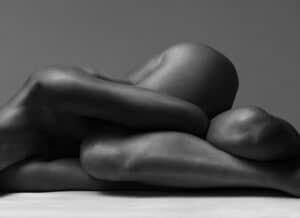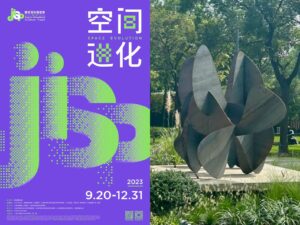
‘Winston’, is a bronze sculpture by our artist Cécile Raynal, unveiled on the 1st October at Cap d’Ail with Prince Albert II of Monaco in attendance. Installed in the Villa Capponcina, where Churchill came to paint during the post-war years, it celebrates the tie between the illustrious man and the city on the French Riviera. Find out more about the concept and creation of ‘Winston’ in this article.
Winston Churchill, painter at Cap d’Ail
The link between the town of Cap d’Ail and Winston Churchill is through his friendship with Lord Beaverbrook, a businessman, publisher and former minister in his wartime cabinet. The latter had bought Villa Capponcina in Cap d’Ail, a neo-Provençal style villa built in the 1920s for the renowned couturier and perfumer Edward Molyneux. In the post-war years, Winston Churchill stayed there several times during his holidays. There, inspired by the landscapes and the tranquillity of the place, he devoted himself with a passion to painting and he wrote his memoirs. In 1952, the town of Cap-d’Ail granted him through the Minister of the Interior’s decree, the title of honorary city mayor, ‘in honour of a great friend of France and of the town’.
The creation and installation of a bronze sculpture of Churchill in the villa celebrates the 70th anniversary of the title’s award, marking this special link between the city and the illustrious man. The current mayor, Xavier Beck, already knew the French sculptress Cécile Raynal’s work, as she had previously exhibited in 2011 and 2016 at the Château des Terrasses, a Belle Epoque villa, near Cap d’Ail. After seeing her bronze portrait of Pierre Rolinet, a former resistance fighter and deportee during the Second World War, he decided to get in touch with her to commission the Churchill sculpture.
Work on the historic person
This project was a real challenge for the artist, first of all the very limited timescale given: just two months to deliver the clay sculpture to the foundry. The constraints were also iconographic, as the sponsor wanted a sculpture of Churchill standing and wearing a classical hat (for ease of recognition), whilst he actually painted sitting down with a large Panama hat.

Until then, Cécile Raynal had only created one portrait of a historic person: that of Olympe de Gouges. The portrait was more literary than historical, as there is only one existing painting of the authoress. Winston Churchill, on the other hand, has been widely seen in photos, videos, portraits, statues, etc… The first question that the artist asked herself therefore was: how to paint a portrait of Churchill ‘the man’, the thinker and painter, and not the politician or hero?
As often during her creative process, Cécile Raynal starts off immersing herself into the character’s life and world: she read Churchill’s biographies, his speeches, the letters between him and his wife, a part of his war diary. She also looked at images of him as a child and young man, archival war footage and of course, his paintings.
Several identities, one sculpture
The artist’s aim was to pass on the multiple identities and personality traits of the politician into the portrait sculpture: his humour, his intelligence, but also his harshness and a certain torment. To that end, Cécile Raynal tried to imagine a fictional meeting with Churchill, where she engaged with his different lives and voices. The sculpture that emerges from the meeting shows the artist’s embedded ambivalence towards the historical figure: curator and aristocrat on the one hand, but also saviour of Europe thanks to his strength and courage. Cécile Raynal’s Churchill clothes are that of an aristocrat and politician, with a painter’s jacket over them and paintbrushes in his pocket. He also has a cigar, which he had on his wedding day, and a cane in hand.
“As for every portrait, every meeting, the quality of the sculpture in-hand is due to the permeability of my hands, their ability to perceive the one who, as in this case has gone, set in images and omnipresent. To let oneself be almost absorbed into the different Winstons, with many lives whose history have changed History. […] There was also a Winston the painter, writer, lone and prone to long episodes of depression, capable of contemplation and creation. Basically, I’ve got the feeling that above all it is with that man, that I converse with in clay.”

The depictions of Churchill at different ages and in different poses helped the contemporary sculptress find a way forward, but another essential part in creating the portrait is the use of models who came and posed for the artist. In particular, a friend with a similar corpulent build to the English politician provided her with the right anatomical mass and size references. The work is divided into several phases: initial sketches, then reduced scale clay sculptures. According to the artist, the smaller scale models help to “start writing the terms of the potentially risky relationship with a man who is no longer around”.

The artist then moves on to work on the large-scale clay sculpture. Once finished, it is fired in four separate parts, then assembled. The final sculpture is delivered to the foundry who create the mould and wax model, with any corrections done by the artist. Through the wax mould process, the final bronze sculpture is cast, ready for the final phases: the chasing is done by Cécile Raynal and the patina is carried out by the foundry under her instructions.
The bronze sculpture ‘Winston’ was unveiled on the 1st October 2022, at Cap d’Ail, with Prince Albert II of Monaco and Mr. Kirill Minovalov, patron of the work in attendance. It is installed in the garden of Villa Capponcina, overlooking the coastal path. “Winston will be standing facing the horizon that he loved so much, overlooking the coastguards’ path, between the blues of the sky, the sea and the walkers. Paintbrushes in his pocket…” Cécile Raynal

Photos: Bernard Hébert (except the first and last ones)





